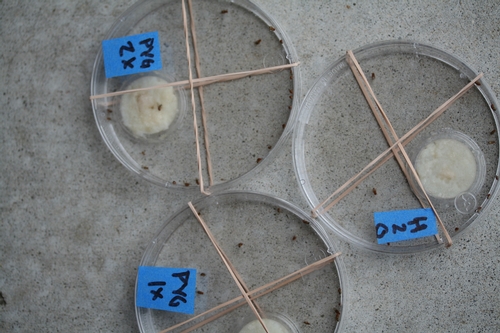It was perhaps only inevitable that some laboratory work with a private industry researcher has discovered a high level of tolerance, maybe even resistance, to the popular organically registered pesticide Pyganic (active ingredient pyrethrin) in spotted wing drosophila. Using the system of Petri plates photographed below, groups numbering from 15 to 22 flies were subjected to the label rate (18 fl oz) and twice the label rate (36 fl oz) of Pyganic 5.0 II with the result that spraying them had very little effect and most survived. This has been repeated several times, so we know it is not by chance that this is happening.
The population subjected to this laboratory testing has been exposed in the source field to many applications of Pyganic- there's not a lot of choices in organic culture- over the past two years, so it comes as no surprise. Admittedly it seems rather fast. Do note also that pyrethrin is a weaker version of the synthetic pyrethroids such as zeta cyper-methrin (Mustang Max) and bifenthrin (Brigrade) so we do have a flashing yellow with these materials also.
It is so important that we continue to rotate the pesticides we are using against spotted wing drosophila.
Attached Images:

Sample of Petri plates used for testing of 1x and 2x label rates of Pyganic along with water sprayed control.